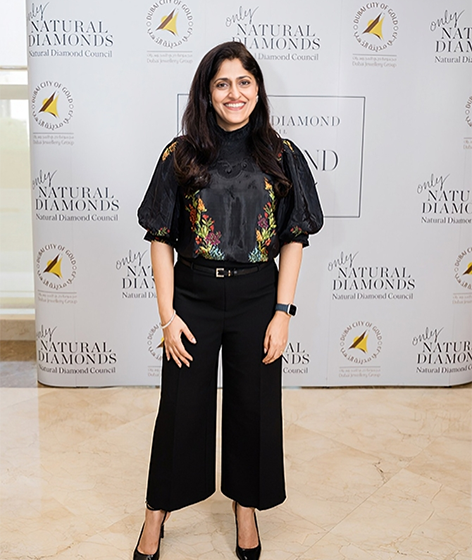Movie magic, plush seats, and gourmet treats.. ROXY Cinemas brings the big screen to Circle Mall JVC
Richa Singh: “Natural Diamonds are about Legacy and More ”

Richa Singh.. Managing Director of the Natural Diamond Council for India & the Middle East on the future of the diamond industry, Dubai’s growing influence, and the balance between tradition and innovation.
Leading the organization’s mission to promote transparency, consumer education, and sustainable growth, Richa is at the forefront of shaping how the next generation perceives natural diamonds.
We sat down with her during the first edition of the “Diamond Dialogue” event in Dubai an initiative by NDC in collaboration with Dubai Jewellery Group to discuss the industry’s evolving landscape, the rise of lab-grown diamonds, and why emotional value of natural diamonds will always outshine trends.
Here are some of our questions to her..
– Can you tell us about the Diamond Dialogue event and its purpose?
Richa Singh: The Diamond Dialogue is our first open discussion bringing together every part of the diamond supply chain from miners and manufacturers to retailers and designers.
The idea is to create a platform where we can honestly discuss challenges, share perspectives, and identify actionable steps to strengthen the industry.
Dubai is globally known as the “City of Gold.”
We believe it can also become a destination for natural diamonds.
That’s why we’ve partnered with the Dubai Jewellery Group to make Dubai not just a place to buy gold, but also a hub for consumers seeking quality diamond jewelry.
– What are the biggest challenges facing the natural diamond industry today?
Richa: One of the biggest shifts has been in consumer behavior.
Earlier, the jeweler was almost like a family member the trusted person who helped you choose pieces for major life events. Today, consumers have access to endless information online, social media influences, and global perspectives.
That’s wonderful, but it also means our industry must keep up. Retail teams need to be as knowledgeable as their customers, if not more. Empowered, educated consumers are great for the category but only if we equip ourselves to meet their expectations.
Another challenge is that Dubai attracts a global audience people from India, Russia, Africa, the U.S., and beyond.
Retailers must know how to communicate across cultures, understand diverse tastes, and connect emotionally with every customer.
– How has the fluctuation in gold prices affected the diamond market?
Richa: Rising gold prices have actually created a new opportunity for us.
Traditionally, many consumers only bought 21K or 22K pure gold jewelry. Now, they are exploring 18K studded pieces which often include natural diamonds. We’re seeing many first-time diamond buyers from smaller towns and new markets.
It’s a positive shift. The challenge for us is to ensure we maintain the highest standards in design, craftsmanship, and consumer education, so the value and beauty of Real Diamond jewelry remain clear and compelling.
– The rise of lab-grown diamonds has created confusion for consumers. How do you see this evolving?
Richa: Lab-grown diamonds have been around since the 1950s. Initially, they were used for industrial and technological purposes in surgeries, tools, and electronics.
In the last 25 years, they entered fine jewelry, positioned as a high-value alternative. But as production scaled up dramatically, prices dropped sharply.
For example, a three-carat lab-grown diamond can now sell online for under $200. That’s not competition for fine jewelry it’s a different category altogether.
At the NDC, we see natural and lab-grown diamonds as parallel categories. Natural diamonds are billions of years old, unique, and hold emotional and generational value. Lab-grown diamonds are mass-produced, accessible, and fun perfect for fashion-forward designs or trend-based accessories.
Both can coexist as long as consumers are informed and can choose consciously.
– Can consumers easily tell the difference between the two?
Richa: To the naked eye, it’s almost impossible.
But every legitimate jeweler today carries advanced detection machines that can identify a diamond’s origin within seconds. Certification is also standard practice.
What’s changed is that certification now applies to entire jewelry pieces, not just loose stones. Institutions like GIA have also updated their grading systems to reflect the difference between natural and lab-grown stones, emphasizing that they are fundamentally different products.
– Many people say diamonds don’t hold resale value. What’s your response to that?
Richa: That’s one of the most common misconceptions.
Some major retailers now offer 100% buyback on their own natural diamond jewelry. But beyond that, I always say: a diamond is not meant to be traded like gold; it’s meant to be treasured.
When you buy a diamond to mark the birth of your child, or a special milestone, it becomes a symbol of emotion and memory not just an investment.
No one smiles looking at their mutual fund statement, but you’ll always smile when you look at your jewelry and remember the story behind it.
That’s what makes diamonds unique they hold emotional, generational, and intrinsic value.
– Do you think cultural habits in the Middle East are shifting toward diamonds?
Richa: Absolutely.
For decades, this region has been synonymous with gold. It’s part of the cultural and economic identity here. But times are changing.
Today’s consumer is globally aware influenced by Parisian couture, Italian design, and American bridal trends. So the market is evolving into a hybrid of tradition and modernity.
We’re seeing a growing appreciation for natural diamonds as part of everyday luxury, not just for weddings or milestones.
– Finally, what do you see as the future of the natural diamond industry?
Richa: The future is very bright.
Consumers today value authenticity, sustainability, and storytelling. Diamonds embody all three. They are billions of years old, the oldest piece of history you can ever own, and each one carries a story that grows as it’s passed down.
As I always say:
“Every piece of diamond jewelry has a memory. You remember when you bought it, why you bought it, and what it meant at that moment. That’s something no trend can replace.”
In Closing
Richa Singh’s message is clear the allure of natural diamonds goes far beyond sparkle or price. In a world driven by fast trends and fleeting fashion, their timelessness, authenticity, and emotional resonance make them a category of their own.
Under her leadership, the Natural Diamond Council is not just promoting a product it’s preserving a legacy.

















